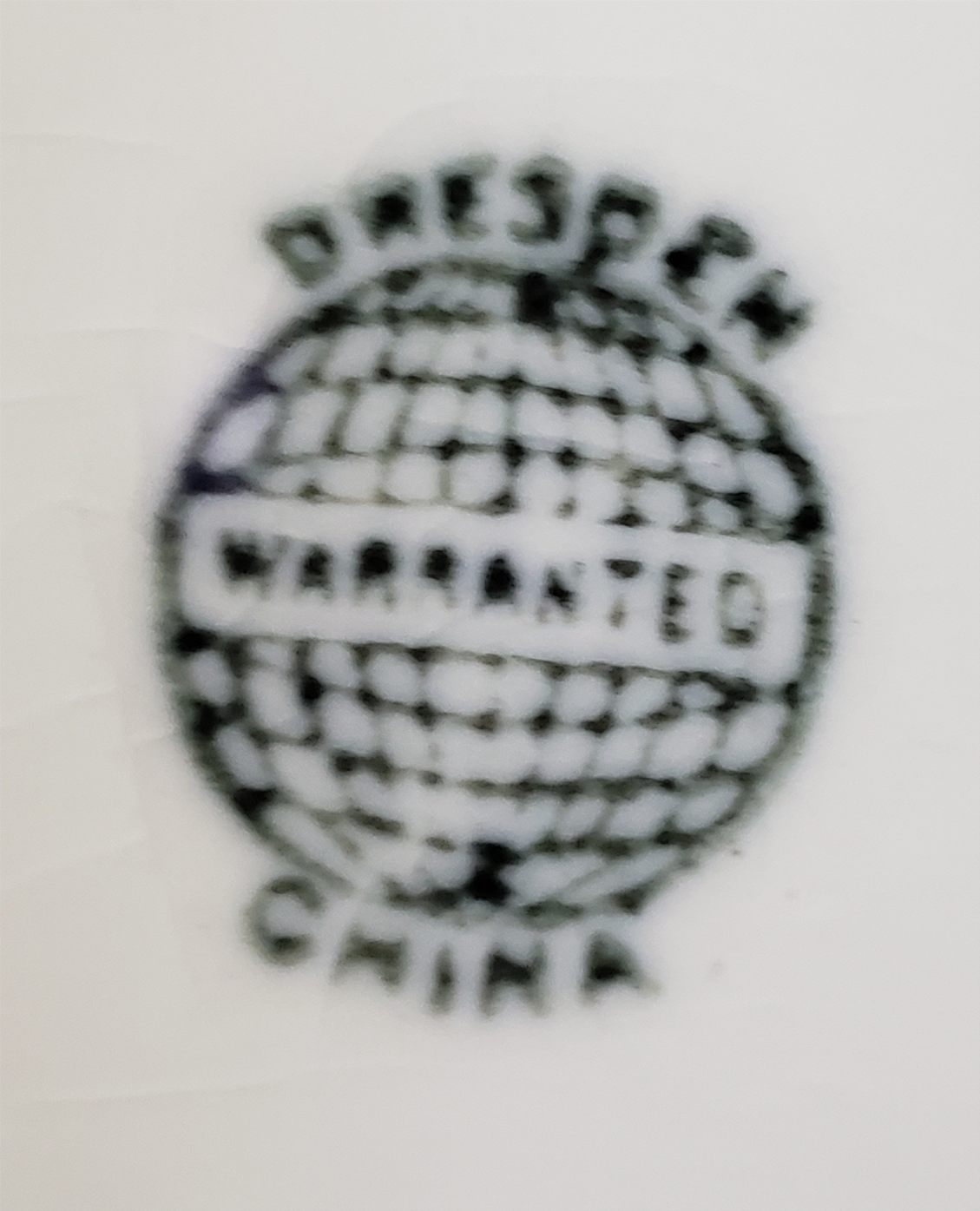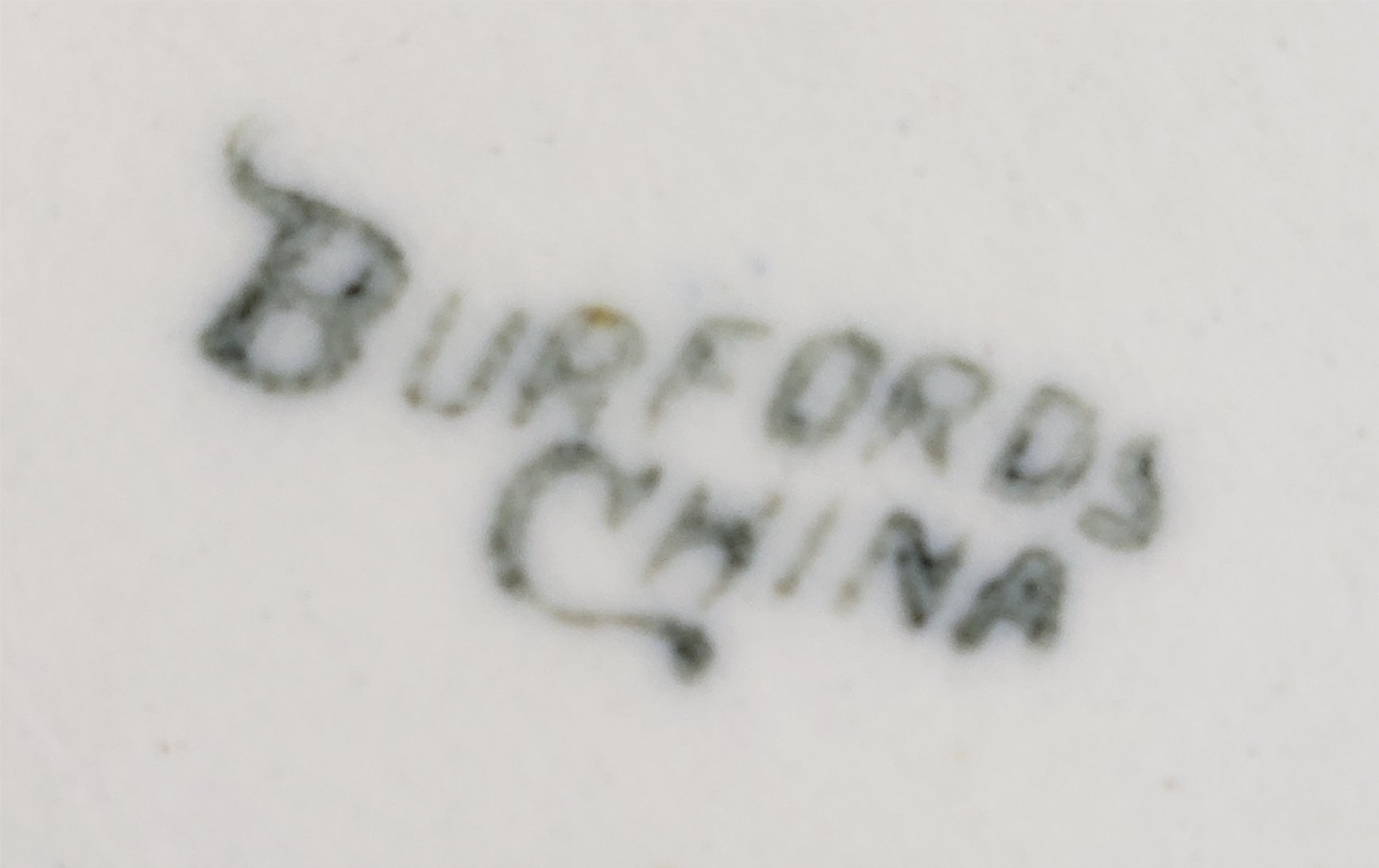Gallery ~ 5
Edwin M. Knowles China Company
TITLE: Potomac Yellow Jasmine
MAKER: Edwin M. Knowles China Company
DATE: 1939
COLLECTION: Mark LeCain
In 1914 the Edwin M. Knowles China company opened a new plant in Newell, WV. They successfully operated potteries in Chester and Newell until early in the 1930s when they sold the Chester plant to the George Harker Company and consolidated their business at the Newell plant. (Gates, 2009, Gonzalez, 2017).
TITLE: Potomac
MAKER: Edwin M. Knowles China Company
DATE: 1939
COLLECTION: Mark LeCain
Edwin Merchant Knowles was the youngest son of Isaac Knowles (Knowles, Taylor & Knowles) and in 1900, along with C.A. Smith and Albert Mason they announced the building of a new pottery in the new community of Chester, West Virginia. The Edwin M. Knowles China Company was the first to build across the Ohio River from East Liverpool. From this beginning, by the second decade of the 20th century many of the larger East Liverpool potteries had relocated to Chester or Newell due to the availability of ample land for development of new style potteries, and the incentives given by the state of West Virginia to encourage industrial development in the panhandle.
TITLE: Deanna
MAKER: Edwin M. Knowles China Company
DATE: 1938
COLLECTION: Museum of Ceramics/Ohio History Connection H 3219
Tea Trivia:
Drinking tea has been depicted in the movies throughout the decades. Here are ten movies in which tea was featured: You’ve Got Mail (1998); How to Make an American Quilt (1995); The Great Gatsby (2013); Suicide Squad (2016); The Second Best Exotic Marigold Hotel (2015); The Hitchhiker’s Guide to the Galaxy (2005); Alice in Wonderland (2010); The Great Escape (1963); Mary Poppins (1964); Mona Lisa (1986); The Lion, the Witch and the Wardrobe (2005); The Hobbit and Lord of the Rings (2012/2001); Harry Potter and the Prisoner of Azkaban (2004) Can you think of more? (Walker, 2021).
TITLE: Forecast
MAKER: Edwin M. Knowles China Company
DATE: 1957
COLLECTION: Mark LeCain
Forecast was one of the last Edwin M. Knowles dinnerware styles. The company closed in 1962.
In an undated entry in The West Virginia Review (p 438 ) the Edwin M. Knowles China Company is noted as the “second largest dinner ware manufacturing company in the United States.” The plant in Newell, with 19 kilns and the plant in Chester with seven, were both in operation at the time. In the article, Knowles details the pottery process and praises the skill of his workers, both men, boys, and girls. Work was paid by the piece, as is often the case today in the pottery. The pottery was unionized and Mr. Knowles commented on the need for the pottery industry to move forward with design, decoration, and color. He highlighted several of the company lines including the Marion (1930), Mayglow (1930) and Mayflower (1914). (Conley).
TITLE: Criterion
MAKER: Edwin M. Knowles
DATE: 1954
COLLECTION: Mark LeCain
Tea Trivia:
Earl Grey tea was named after Earl Charles Grey of England who was Prime Minister from 1830 to 1834. Even though he accomplished such feats as eliminating slavery, the Earl is most remembered for his namesake tea. Legend has it that the recipe for this tea was named for Grey as a thank you gift for having saved the son of a Chinese tea blender from drowning. As a gift, the blender presented the recipe for this black tea which was flavored with bergamot oil. It is thought to be highly unlikely however, that Earl Charles Grey ever visited China or performed this heroic act. It may have just been named after him because he was a powerful leader of the day. (Goodwin, 2019).
Potters Co-operative Company
TITLE:
MAKER: Potters Co-operative Company
DATE: 1882-1895
COLLECTION: William and Donna Gray
In 1882 there was a dispute among pottery workers and owners concerning the unionization of workers under the Knights of Labor. Eight local potteries came together and passed the “Iron Clad” contract in an attempt to exclude union workers.
To combat these efforts, a group of potters led by Hugh A. McNicol purchased a 75% share of the Dresden pottery of Brunt, Bloor, Martin and Company. They set up business as the Potters Cooperative. The cooperative did not survive more than a year but the name was retained under reorganization and the pottery survived until 1925. (Gates, 1984, 2009).
TITLE:
MAKER: Potters Co-operative Company
DATE: c 1897
COLLECTION: William and Donna Gray
The Dresden pottery was purchased with assistance from the Knights of Labor and the potters who were operator/workers of the Potters Cooperative took stock in lieu of a portion of their wages. All profits were divided among the stockholders. (Gates, 1994).
Hugh A McNicol, was president of the Potters Cooperative until his death in 1914. Following his death, Elizabeth, his wife, took over until August 1918 when she too passed away and their son, Harry was elected president of the company. (Barth, 1926).
TITLE:
MAKER: Potters Co-operative Company
DATE: 1890-1900
COLLECTION: William and Donna Gray
TITLE:
MAKER: Potters Co-operative Company
DATE: 1882-1895
COLLECTION: William and Donna Gray
TITLE:
MAKER: Potters Co-operative Company
DATE: 1882-1895
COLLECTION: Williamd and Donna Gray
in 1883, some disgruntled Potters Co-operative workers quit the company and formed the Standard Co-Operative Company. (Witt).
This teapot is decorated with a transfer print of moss rose, highlighted with hand applied color. Moss rose was a favorite flower of the Victorian era and was used by numerous potteries to decorate ware.
TITLE:
MAKER: Potters Co-operative Company
DATE: 1890-c 1900
COLLECTION: William and Donna Gray
Tea Trivia:
In China the bride and groom will prepare tea and serve their in-laws as a sign of gratitude for acceptance into the family. (Dixon, 2016).
The applied decoration is, again, a transfer print with added gold lining and sponging near the top.
TITLE:
MAKER: Potters Co-operative Company
DATE: 1895-1910
COLLECTION: William and Donna Gray
Tea Trivia:
The tradition of pouring milk into a cup before adding the hot tea was started so the hot liquid would not crack the cup. Josiah Spode (1733-1797), one of Stoke-on-Trent’s foremost potters, perfected a bone china teacup that held up to the hot tea. Those who could not afford these delicate but sturdy cups had to continue pouring the milk in first and it has remained a tradition in much of Britain. (Barrie, 2018).
TITLE:
MAKER: Potters Co-operative Company
DATE: 1895
COLLECTION: William and Donna Gray
Tea Trivia:
One of the benefits of drinking tea is that it has high levels of antioxidants. This causes the caffeine to absorb more slowly into the drinker’s system keeping the drinker alert longer. (Chamberlain, 2019).
French China Company
TITLE:
MAKER: French China Company
DATE: 1898-1916
COLLECTION: William and Donna Gray
The French China Company was organized by the Sebring brothers in 1898, in an area of town known as Klondyke. The name was given by local residents to indicate the pottery’s great distance from the center of the industry, which was centered around Second Street. In 1901, they moved the company to Sebring where the French China Company continued production until 1929. (Gates, 2009).
Burford Brothers
TITLE: Cable
MAKER: Burford Brothers
DATE: 1881-1904
COLLECTION: William and Donna Gray
Child size Cable shape in a blue spatter glaze.
In 1879, Robert, George, and Oliver Burford erected a pottery for the production of floor and wall tiles. This venture was unsuccessful and in 1881 they converted the pottery to the production of white granite and CC ware (cream color).
By 1887, they had a two kiln operation and, like most East Liverpool potteries, shipped to the American West and Northwest. The Ohio River gave the local potteries access to the Mississippi and points west. Trenton, New Jersey and British ware were formidable competitors in the East. (Gates, 2009, Burford).
TITLE: Coral
MAKER: Burford Brothers
DATE: 1881-1904
COLLECTION: William and Donna Gray
The Burford Brothers sold their business to the Standard Pottery Company in 1905.
Each Burford brother remained in East Liverpool. Oliver’s home had 21 rooms and a separate “house” for the servants. (Allison, 2021).
TITLE:
MAKER: Burford Brothers
DATE: 1881-1904
COLLECTION: William and Donna Gray
As the 19th century drew to a close, American pottery had grown in quality and was recognized in Britain as such. The competition from Trenton, New Jersey potteries was the next obstacle to overcome. In 1896 the Burford Brothers shipped a consignment of Jardiniers (flower pots) to a Trenton pottery company for display at the New Jersey State Fair allowing the wider pottery consumer to see, purchase, and use East Liverpool wares. (Trenton, 1896).





































